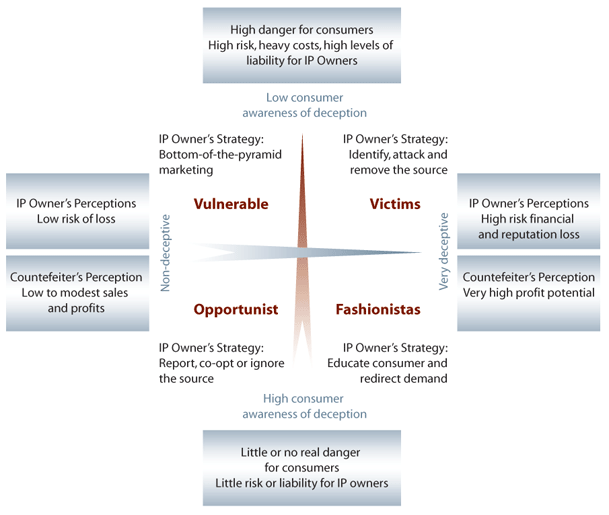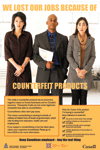
Targeting Buyers of Counterfeit Goods
By Lyn S. Amine and Peter Magnusson
This article is a condensed version of the research paper, “Cost-Benefit Models of Stakeholders in the Global Counterfeiting Industry and Marketing Response Strategies,” by Lyn S. Amine and Peter Magnusson, which appeared in the Multinational Business Review, 15(2): 1-23 (2007).
Governments, international policymakers and corporate intellectual property (IP) owners wage constant war against global counterfeiting. However, there are those with a clear interest in promoting this illegal trade, including the counterfeiters themselves and many consumers. Resistance on the supply side alone is inadequate to control or even curb the counterfeit trade. The demand side of the market, composed of consumers, must also be addressed. A framework is outlined to assist international marketing managers and other business people in understanding the important role of creative and proactive marketing in resisting both counterfeiters and consumers of their goods.
Most initiatives to thwart counterfeiting fail because consumer attitudes and behaviors are factored inadequately, if at all, into the analysis. This is surprising, given consumers’ expectation that it is up to their governments to protect them against dangers from counterfeit medicines, car parts, airplane components and other potentially fatal products. Paradoxically, these same consumers defend their right to choose between expensive, genuine brand-name products and much cheaper but inferior counterfeits.
Most consumers believe that they can recognize counterfeit products. Many view these as a source of enjoyment, especially in the case of fashion items which are knowingly purchased at a lower price regardless of quality. Such consumer attitudes are at odds with legal standards, moral values, publicly stated corporate codes of conduct and even the consumers’ own well-being. Even if consumers suspect potentially negative consequences, their desire to be fashionable and to keep up with friends and peers lead them to ignore these. If such attitudes are not factored into the analysis of consumer involvement in the counterfeit market, then initiatives to dissuade consumers from these purchases will remain ineffective.
Success in fighting counterfeits requires targeted actions involving all stakeholders on both the supply and the demand sides of the market as well as a clear-sighted evaluation of respective costs, benefits and trade-offs. Hence consumers are at the center of a complex global market in which several parties pursue their own interests, each involving conflicting cost-benefit analyses.
Consumer accomplices: the naive and the cynical
Consumer accomplices – the buyers of counterfeit goods – promote illegal trade through their willingness to perpetuate demand for counterfeit products and services. Some of these consumers, notably young people, are naïve: they enjoy hunting for good deals and believe that they can easily tell the difference between legitimate and illegitimate goods, regarding counterfeit fashion goods as harmless fun. They trust their government to take steps to protect them from the invisible dangers of illegitimate counterfeit products, all the while believing that they themselves do little harm by buying counterfeit fashion goods. Other consumer accomplices, however, are cynical in their complicity. They freely admit to having bought counterfeit goods knowingly; they see no moral wrong and do not mind colluding with counterfeiters in order to get a good deal. It is not surprising, then, that efforts by governments, international agencies and companies to curb counterfeiting have not worked: global demand is too strong and persistent.
Our research leads to several conclusions illustrating fundamental differences between consumer accomplices and official resisters:
1. Many consumers consider most or all counterfeit products to be “non-deceptive,” and believe that they can make a conscious choice between a genuine and fake product.
2. Many consumers are actually unaware of the dangerous nature of deceptive counterfeit products.
3. Governments, international agencies and corporate IP owners, though aware of the complexity of the problem, often group all counterfeit products together as deceptive and as potentially, if not actually, harmful to consumers in particular and to business and society in general.
The role of marketing
If consumer accomplices are not deterred either by the fear of harming themselves or others or by the threat of legal consequences or punishments, and if they are willing to trade off lower quality for lower prices, then which marketing strategies will effectively change their attitudes? We begin by first categorizing consumers and types of products; then we propose four marketing strategies tailored to meet each type of demand.
This framework highlights the fundamental contradictions between three sets of stakeholders: counterfeiters, corporate IP owners and consumers. The multi-layered design of the framework draws attention to the complexity and multi-dimensionality of interfaces between stakeholders; it also promotes consideration of multiple simultaneous frames of reference.

This figure presents an analysis of cost-benefit trade-offs by corporate IP owners, global consumers and counterfeiters.
Consumer points of view
Four types of consumers who buy, use or are exposed to the different types of products are identified and named in each quadrant. Counterfeit products run from the non-deceptive to the deceptive along the x-axis and the y-axis representsconsumers’ degree of awareness of deception and the risk of danger from counterfeit products.
Victims are consumers who are unaware that their purchases are counterfeit because these items are highly deceptive (for example heart valves, prescription drugs airplane parts) and suffer actual physical harm. In contrast, cynical consumer accomplices, who knowingly buy highly deceptive fake designer handbags, jewelry, apparel, etc. for the simple purpose of impressing others and do not suffer any ill effects, are called Fashionistas. In the category of non-deceptive products, cynical consumer accomplices who are aware that the quality is poor and that items – convenience and shopping products such as foodstuffs, household equipment and supplies – are counterfeit, are called Opportunists. Vulnerable consumers are unaware that products – brand-name staples such as household products, cosmetics, auto parts, over-the-counter drugs – are fake, despite visible poor quality, and often run a high risk of harm. This group includes the very young, the elderly, the poorly educated and illiterate consumers, none of whom may be able to make an informed choice.
Counterfeiter points of view
From the counterfeit producers’ point of view, non-deceptive products offer only low levels of sales and profits, because consumers easily perceive the poor quality and make only opportunistic one-time purchases. Consequently, counterfeiters only operate in this entry-level type of business for a short period of time. In contrast, deceptive high-quality counterfeits offer high profit potential to counterfeiters. Thus, the higher the degree of deceptiveness, the greater the products’ perceived market value and the greater the profit potential for counterfeiters.
IP owners
All counterfeits – even the non-deceptive shopping goods bought by Opportunists – are perceived by IP owners as damaging to their brand image. IP owners may feel less of a sense of urgency when dealing with non-deceptive counterfeits as Opportunists can easily tell them apart fromgenuine goods; however, Vulnerable consumers run a high risk of harm, so non-deceptive counterfeits cannot be ignored even though IP owners run the risk of small liability or loss.
In contrast, the high-quality and sophisticated appearance of deceptive products constitutes a serious concern to IP owners, due to the high risk of harm even for alert buyers and users. Fashionistas may risk nothing themselves, but the corporate IP, revenues and reputation are all put in jeopardy. There are also risks that Victims who suffer harm due to counterfeit medical devices or industrial equipments will sue and that negative publicity will harm the IP owner’s business.
Marketing responses

One in a series of posters by the Canadian Anti-Counterfeiting Network. (Photo: Canadian Anti-Counterfeiting Network)
The four proposed strategies go beyond curbing illicit supply to reduce or eliminate consumer demand for counterfeits.These strategies will also increase awareness among specific sectors of the population, change their attitudes, modify behaviors on the consumer demand side and can be immediately implemented by international marketers.
Fashionistas – educate and redirect demand: Publicize criminal prosecutions of illegal consumer behavior; use “buzz marketing” to spread the word among peer groups that buying counterfeit goods is no longer acceptable; promote social disapproval of ownership of counterfeit items. PETA’s “Fur is Dead” buzz marketing campaign* provides an excellent example of how to do this.
Opportunists – report, ignore or co-opt the source:Report counterfeiters; co-opt suppliers; ignore illegal businesses which will eventually fail due to lack of profit potential; consider extending product lines or introduce new products; position brands and set prices appropriately for the income levels of Opportunists.
Vulnerable consumers– apply bottom-of-the-pyramid (BOP) marketing: Co-create products and services appropriate to the needs of consumers with very limited economic resources. Low prices will allow BOP consumers to purchase basic necessities and achieve improved quality of life.
Victims – identify, attack and remove threats: Joint actions by IP owners with other companies, national governments, international agencies, legal institutions and security forces are needed in order to identify and prosecute criminals. Imposition of the heaviest penalties available through the systems along with widespread publicity about these actions, will serve as deterrents for other illegal operators.
In future, marketers should publish case studies of their company’s success stories and best practices, demonstrating results from these strategies. Government leaders and international policymakers must also share results of their action plans (through WIPO and WTO) so that the most effective response strategies can be implemented worldwide. Adoption of these perspectives, approaches and strategies will diminish counterfeiting by controlling both supply and demand, and will create legitimate new market opportunities for consumers of all types.
_____________________
* People for the Ethical Treatment of Animals 2006
The WIPO Magazine is intended to help broaden public understanding of intellectual property and of WIPO’s work, and is not an official document of WIPO. The designations employed and the presentation of material throughout this publication do not imply the expression of any opinion whatsoever on the part of WIPO concerning the legal status of any country, territory or area or of its authorities, or concerning the delimitation of its frontiers or boundaries. This publication is not intended to reflect the views of the Member States or the WIPO Secretariat. The mention of specific companies or products of manufacturers does not imply that they are endorsed or recommended by WIPO in preference to others of a similar nature that are not mentioned.